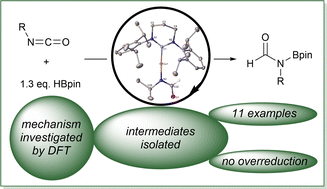Selective hydroboration of electron-rich isocyanates by an NHC-copper(i) alkoxide†
Abstract
The (IPr)CuOtBu catalysed reduction of 11 aryl and alkyl isocyanates with pinacolborane gave only the boraformamides, pinBN(R)C(O)H, in most cases. Overreduction, which hampers almost all isocyanate hydroborations, was restricted to electron poor aryl isocyanates (4-NC-C6H4NCO, 4-F3C-C6H4NCO, 3-O2N-C6H4NCO). Computational analysis showed stability of [(IPr)CuH]2, which was proposed to be the catalyst resting state, drives selectivity, suggesting an approach to prevent overreduction in future work. In the case of iPrNCO, formation of this species renders overreduction kinetically inaccessible. For 4-NC-C6H4NCO, however, the barrier height for the first step of over-reduction is much lower, even relative to [(IPr)CuH]2, resulting in unselective reduction.



 Please wait while we load your content...
Please wait while we load your content...